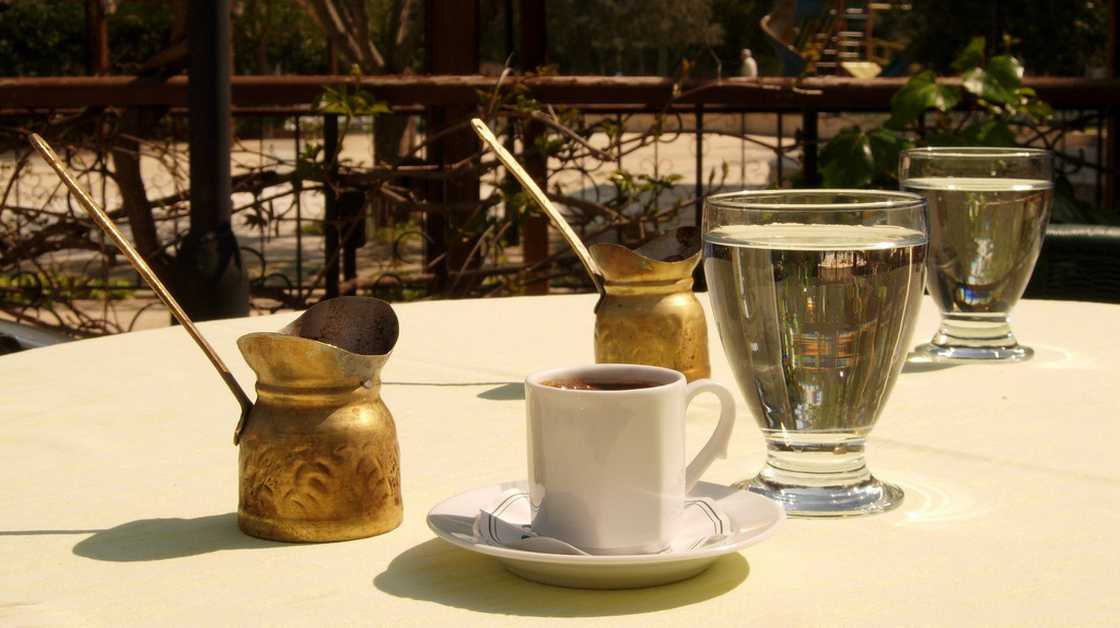by JOANNA KAKISSIS
Throughout the region that was once the Ottoman empire, people make coffee pretty much the same way: using coffee beans ground into a fine powder, then boiled in a little brass pot that the Turks call a cezve.
maxpax/via Flickr
When I was in Istanbul in March, I stopped by a tiny cafe called Mandabatmaz, near Taksim Square. Ten Bulgarian tourists were inside, waiting for demitasses of rich, strong coffee “so thick even a water buffalo wouldn’t sink in it,” according to a translation of the cafe’s name.
I ordered a cup of the velvety coffee, crowned with a bubbly froth.
“A beautiful Turkish coffee,” said one of the Bulgarian tourists.
Back home in Bulgaria, as well as Slovenia, Hungary, Romania, Iran and Israel, they do call this “beautiful coffee” Turkish. And they make it pretty much the same way: using coffee beans ground into a fine powder, then boiled in a little brass pot that the Turks call a cezve. The coffee is ready when it rises, bubbles and nearly overflows.
The style of coffee, also known as Arabic, first came from Yemen. An Ottoman governor stationed in Yemen in the 16th century fell in love with it and introduced it to Sultan Suleiman the Magnificent, who popularized coffee in Istanbul and beyond.
A century later, Sultan Murad IV outlawed coffee, calling it an indecent drink, and chopped off the heads of those who drank it. The coffee, obviously, won out.
But ordering Turkish coffee today doesn’t go over well in some Balkan or eastern Mediterranean countries that were once part of the Ottoman Empire — even if their preparation of the coffee is remarkably similar.
In Armenia, where the Ottomans led a genocide against more than a million people between 1915 and 1923, it’s Armenian coffee. In Sarajevo, Bosnia, I once ordered a “Turkish coffee” only to be corrected by the irritated waiter: “You mean aBosanska kafa” — a Bosnian coffee. In Cyprus, which the Turks invaded in 1974, it’s a kypriakos kafes — Cypriot coffee. (Except in the northern third of the island, which Turkey has occupied since 1974.)
In Greece, where I live and which has a tortured history with Turkey, you order anelliniko — a Greek coffee.
“It wasn’t always this way,” says Albert Arouh, a Greek food scholar who writes under a pen name, Epicurus. “When I was a kid in the 1960s, everyone in Greece called it Turkish coffee.”
Arouh says he began noticing a name change after 1974, when the Greek military junta pushed for a coup in Cyprus that provoked Turkey to invade the island.
By the 1980s, Arouh noticed it was no longer politically correct to order a “Turkish coffee” in Greek cafes. By the early 1990s, Greek coffee companies like Bravo (now owned by DE Master Blenders 1753 of the Netherlands) were producingcommercials of sea, sun and nostalgic village scenes and declaring “in the most beautiful country in the world, we drink Greek coffee.”
Nationalism was one reason for the change, says Marianthi Milona, a Greek cookbook writer who grew up in Cologne, Germany. “But it was also a way to differentiate from other kinds of coffee.”
In the first half of the 20th century, the only coffee in Greece was “Turkish” coffee. Then came frappe, the iced drink made from instant Nescafe. Then espresso and cappuccino, which are now the hottest items in most Greek cafes. “So the ‘coffee’ — the first coffee — had to have a name too,” she said. “And because we are in Greece, we decided it must be Greek.”
In Athens, my uncle Thanassis, who has been making this coffee for more than 60 years, waits until the water in the pot is warm before adding the powdery grounds. He stirs the mixture until it looks creamy. In Istanbul, I noticed the man making the coffee at Mandabatmaz adding a few drops of hot water to spoonfuls of coffee and sugar, then whip-stirring the mixture into a dark paste. He then added more hot water to the pot before boiling it to velvety perfection over a gas flame.
My uncle and I tried the Mandabatmaz method at his house in Athens, with Turkish coffee I’d brought him as a gift from a market in Kadıköy on the Asian side of Istanbul. The coffee was stronger than the Loumidis brand my uncle usually buys but he agreed that it tasted great.
“To Suleiman the Magnificent,” he said, holding up his demitasse in a toast. “Thanks for the coffee.”


Leave a Reply